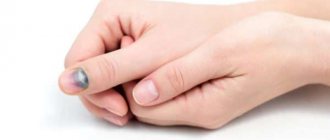When a long-awaited baby is born, parents practically do not let him out of their hands. A newborn baby, adapting to new conditions, most often sleeps restlessly. Therefore, parents choose a well-known way to calm the baby - rocking in their arms.
Works! The baby calms down and falls asleep faster, feeling the warmth of his mother’s hands and her familiar smell. As they get older, it becomes harder to put them to sleep, but children are not so easily ready to give up their favorite sleep ritual. So, the question inevitably arises for mothers and fathers: how to wean a child from rocking in his arms?
Why do children love motion sickness?
To understand why motion sickness acts on a child like a sleeping pill, you need to know how it works and try to imagine the sensations of a baby who is not yet able to realize what is happening. Suddenly, from the small, warm, safe little world in which he was in his mother’s womb, he finds himself in bright light, in the cold and forced to work hard to get food! Of course, with all his little body he strives to feel at least partially the comfort in which he spent his entire little life. And he begins to experience very similar sensations, warming up in his mother’s arms, clinging to a warm chest with a smooth and measured rocking. The baby feels completely safe again, completely relaxes and quickly falls asleep.
Scientists have proven that rocking a baby up to three months has a beneficial effect not only on the child, but also on the mother’s psyche.
In the first months of a baby’s life, a mother rarely gets a chance to fully rest and get a good night’s sleep. The daily rhythm of a child’s life has not yet been established; he is often tormented by colic, gas and other “childish” troubles. Therefore, every minute spent in sleep or at least sweet slumber is of great value for an exhausted mother.
But motion sickness makes it easier to fall asleep not only from a psychological point of view. The physiology of the child is also involved in this process. Uniform smooth movement:
- relaxes, slows down the heart rate, balances the functioning of internal organs and systems;
- trains the vestibular apparatus and prepares the child for the first steps, during which he will learn to maintain balance;
- has an effect on the semicircular canals of the brain, making sleep deeper and more restful.
In order for motion sickness to act as a sedative and have a positive effect on the baby, it is very important not to turn it into galloping with shaking and throwing the body from side to side. Such “physical education” before bedtime will not benefit either the mother or the child.
It is better not to run with a baby in your arms, but to sit and slowly turn from side to side or lean back and forth. At the same time, you can talk to him affectionately or hum a song. But very little time passes, and it becomes increasingly difficult to carry a growing child in your arms. And after a year, children quickly learn to manipulate family members with the help of whims and hysterics.
Therefore, if even modern pediatricians recommend practicing motion sickness up to three months, then after a year, maximum one and a half years, the child must be taught to fall asleep on his own.
Opinions of children's doctors
Below are the opinions of pediatricians about the benefits of motion sickness for children:
- The baby calms down after the pendulum movements, since, while in the womb, he gets used to them. This state for him means a sign of peace. Therefore, rocking before bed is considered natural.
- Not only psychological, but also physical contact with the mother is important for the baby.
- The baby calms down during motion sickness and does not show dissatisfaction in the form of crying or screaming. He feels his mother's touch and her smell.
However, some doctors have a negative attitude towards this process and suggest teaching the baby to fall asleep without motion sickness. They justify their position as follows:
- The child does not feel the need to move like a pendulum, and due to the weak vestibular apparatus, constant long-term motion sickness leads to dizziness and fainting.
- After constant exertion, my mother experiences back pain. The baby is losing the habit of falling asleep without rocking. Therefore, immediately after the birth of the baby, it is recommended to use stroking. When the baby screams and cries, do not rush to pick him up and rock him. Over time, he will get used to it and begin to fall asleep on his own. If the baby is already accustomed to motion sickness, then other methods are used.
Is it necessary to rock the baby?
Young parents are increasingly refusing to rock their newborns and infants. However, pediatricians claim that this opinion is erroneous and recommend such skin-to-skin contact for babies, especially those under 1 year old. Supporters support them, but opponents cite as the main argument the fact that later the problem will arise of how to wean a child from rocking in his arms.
Lulling is an ancient way to quickly calm a baby. But is it worth doing this? Experts are sure: rhythmic rocking in the arms or in a stroller allows a newborn to feel comfortable and calm . In addition, the process serves as training for the baby’s vestibular apparatus.
But there are people who are sure that frequent rocking causes sleep disturbance, and the poor development of the vestibular system of children causes fainting, which inexperienced parents confuse with deep sleep.
Teaching a child to sleep in a crib and stroller
After 10 months, rocking in your arms can be replaced by rocking on a pillow. Most kids like this approach. This helps to wean them off your hands, and then even teach the baby to sleep without motion sickness. In this case, swinging is soon perceived by him as just another pleasant game, and not part of a daily obligatory ritual.
It is not recommended to put down a baby under the age of 1.5 years and leave it alone in the room at night. However, you should not move the crib close to the bed on which adults sleep. The reason for this is standard hygiene requirements. And after 1.5-2.5 years, it is easier to teach a child to fall asleep not in the bedroom, but in the nursery.
However, even in this case, at first, it is better for adults not to leave the room immediately after the child is in bed. And turn on the night light, talk to the baby, not forgetting the importance for him of physical contact with his mother, wait until he falls asleep and only then quietly leave.
How to rock a newborn baby correctly?
The baby can be rocked in your arms while sitting or walking at a calm pace around the room. Special strollers and cribs equipped with shock absorbers are excellent for motion sickness. If you have a fitball or rocking chair at home, you can use these devices.
When rocking your baby, lull him to sleep, sing a lullaby or turn on calm music. Musical accompaniment can be a good alternative when the time comes to wean your baby from motion sickness. Parents' movements should be smooth. It is unacceptable to zealously shake a child in a stroller or in your arms, this can lead to fainting and even spinal injury.
Separately, it is necessary to say about the sling, a special sling for carrying children. For newborns, the best option would be a ring sling. In this device, the baby is attached to his mother, like in a cradle. While doing household chores, many mothers do not even notice at what point the child falls asleep to the calm rhythm of steps.
Video: How to rock a baby
Until what age can you be rocked?
The optimal age for weaning oneself from falling asleep with the help of motion sickness is considered to be one year, the time when the child has already developed a feeding and sleeping routine because, according to pediatricians, children under one year old do not need to strictly adhere to the routine.
At the age of 5-6 months, it is worth trying other methods of falling asleep with your baby, which are described in detail in the article “Going to bed without tears and whims,” so that motion sickness does not become the only way to fall asleep. The article describes in detail ways to stop rocking your baby to sleep and teach him to fall asleep without tears and hysterics. Daily implementation of “sleep rituals,” which include an evening bath and a light massage, reading fairy tales, singing a lullaby, “saying goodbye to the sun,” will gradually teach the baby to fall asleep on his own.
We recommend reading: The child wakes up every hour at night: reasons for frequent awakenings in newborns and advice for parents
Let's see a trick on how you can put a child to sleep in 40 seconds
Comprehensive solution to the problem
How to wean a child from motion sickness in a crib? The first attempts may well be unsuccessful, but do not despair. Often the baby's first reaction is loud crying. However, it does not always mean a protest and a demand to start motion sickness. You should pay attention to the baby’s well-being; perhaps he is worried about colic, has a fever, etc. If this behavior is associated with a disease, then it is recommended to hold him in your arms. In other cases:
- Create the appearance of presence, that is, put some thing in the crib. If the baby smells his mother's scent, he will calm down. Babies react very strongly to lack of contact with their mother.
- Create a comfortable environment in the crib and room: ventilate the room, dim the lights, put a comfortable pillow and blanket, put on nice underwear, etc.
- Wean off motion sickness gradually, reducing the time daily.
Abrupt cessation of motion sickness can injure the baby. In addition, it is not advisable to get carried away with various devices, such as slings.
Why does a baby sleep better in your arms?
The baby may experience increased anxiety.
But he feels safe in his mother’s arms. Not knowing how to wean the baby from rocking in his arms, parents begin to look for the reasons why the baby falls asleep only in this position.
A common cause is considered to be increased restlessness and anxiety experienced by the baby. And in the arms of his father or mother, he feels protected, calms down and falls asleep.
Maintaining tactile communication in this way is especially important in the first months of his life. But do not overdo it, because this causes addiction to falling asleep in your arms and problems with the development of the vestibular apparatus.
Pediatricians explain this feature by the fact that the baby was in the mother’s womb for 9 months, dependent on her warmth, feeling one with her. And after birth, he experiences stress and discomfort, needing a new, no less safe and cozy “nest” that can pass for his mother’s hands.
Why does a child get used to motion sickness?
During all months of pregnancy, the baby in the womb is in a state of rocking. At the same time, he feels warmth, comfort, hears the beat of his mother’s heart and feels protected. This condition becomes habitual for the child.
It takes time for a newborn to get used to the new environment and understand that he is still safe, although he now exists separately from his mother’s body. To calm down, the baby needs to be in familiar conditions, one of which is rocking. This is why many babies only fall asleep if rocked in their arms.
Benefits and harms
Over time, children begin to manipulate their parents and refuse to fall asleep without being rocked to sleep.
When thinking about how to wean a child from rocking before bed, parents think about the advantages and disadvantages of this method of soothing.
Rocking to sleep is one of the important aspects of overall development, because during it the newborn interacts with its parents, receiving their warmth and affection.
There are several advantages:
- Scientists have confirmed that children who were deprived of close contact with their mother in infancy grow up shy and unsociable. Most often, they are not able to stand up for themselves, finding themselves the object of ridicule. As a result of this, their self-esteem decreases, and as they get older, they begin to take revenge on others. Therefore, carrying it in your arms before bed is not only possible, but also necessary.
- This is an effective opportunity to restore the close bond that was established between mother and newborn during pregnancy. After all, while being lulled to sleep, the baby gets the feeling that he is in the womb, where he was calm and comfortable . And smooth and rhythmic movements help to relax the baby and ensure his complete calmness, necessary for the mood for relaxation.
- When cradled in your arms, babies are distracted from the painful sensations that arise from colic or teething.
- Lullaby movements help in a few minutes to calm down a crying and capricious newborn, even in a very overexcited state after active games.
When analyzing these arguments, it becomes clear that lulling during communication or before bed is a component of caring for infants. However, you should not overdo it, so as not to encounter difficulties in falling asleep on your own in the future.
From this publication you will find out whether a newborn can sleep on his stomach and how dangerous sudden death syndrome is in this sleeping position.
There are also disadvantages:
- Before going to bed, you have to be constantly present. But children who are accustomed to falling asleep on their own can fall asleep to a cartoon, a quiet melody, or a quiet game with toys.
- Over time, many babies become accustomed to this method of soothing and putting them to sleep. Therefore, it can be extremely difficult for parents to wean their baby from this ritual.
- Some children realize that adults can easily be manipulated in this way, and begin to demonstrate their character more often, refusing to fall asleep without the usual lulling.
- It is much more difficult to hold a one-year-old baby in your arms than a newborn, because he rapidly gains weight and becomes heavy.
How to wean an infant off your hands: effective methods
- To wean the baby off your hands, you can use the help of loved ones, for example, dad or mom.
For several days, only one person (not the mother) should put the baby to bed, whom the child knows well and is not afraid of. It is important that relatives do not use the method of rocking and do not pick up the child if he starts crying, otherwise all efforts will be in vain.
- Another option is to hire a nanny.
Not everyone can afford to hire someone to care for a child, so you can agree with the nanny that she will come only in the evening for 3-4 hours (for games, help with bathing and putting to bed).
- Psychologists believe that children who are strongly attached to hands do not need hands, but their mother’s presence.
Perhaps the mother devotes little time to the child, and the only way to attract her attention is to try to climb into her arms. What to do in such a situation? Try to devote all your free time to the child: play with him, read books, sing songs, do gymnastics - anything, just don’t hold the baby in your arms.
- If the baby is over a year old, you can switch his attention to toys, books and other things that surround him.
This needs to be done every time he asks to be held by his mother. If this happens on the street, it is easier to cope with the task, since the choice of objects that may interest the child is very large.
- If the baby asks to be held, and the mother needs to finish her business, you can turn on cartoons for him, but you should not abuse this method.
The total amount of time a child spends watching cartoons should be no more than 15-30 minutes a day.
Another way to deal with excessive attachment to your hands is to ignore the crying and continue to do your business. Psychologists do not recommend using this method, as there is a risk of raising a nervous, whiny and restless child, who will definitely have problems at an older age.
How to train someone to sleep without motion sickness?
How to put a baby to bed without motion sickness? How to make a newborn fall asleep on his own? What to do if a child can only fall asleep in his arms? How to wean a child from motion sickness? Experienced mothers advise resorting to some simple tricks:
- Show your love and attention during your waking hours. Pick your baby up often when he's awake. An excellent invention is a sling (more details in the article: sling backpack for newborns). It allows the child to feel the warmth of the mother, and the mother, without making any special physical effort, to be constantly nearby.
- You shouldn't completely give up sleeping next to your parents. A child sleeping next to his mother develops a sense of confidence and security. If you are categorically against your baby sleeping in your bed, create his own cozy and peaceful sleeping place. It should feel warm, soft and comfortable for the baby. You can move the crib close to your own, and after the baby gets used to sleeping alone and without outside help, put it in its place.
- Come up with a substitute mother. A thing that retains the mother's scent can calm the baby and allow him to easily fall asleep on his own. This accessory can be a mother’s T-shirt or shirt. Older children fall asleep better in the arms of their favorite soft toy.
- During the first weeks of your baby's life, do not leave him alone in the dark. Rocking is not necessary. Sometimes it’s enough just to sit next to you and hum a lullaby. A native voice will help you fall asleep.
- Come up with a ritual that will be associated with sleep. Such a ritual could be the same song sung by the mother.
We recommend reading: Applications on Google Play for tracking sleep cycles
Pediatricians say that it is quite possible to wean a child from motion sickness (we recommend reading: how to wean a child from holding hands using Komarovsky’s advice?). The most important thing is to firmly adhere to the chosen position and take the child in your arms not before bedtime, but without being tied to him.
The tips listed are not a panacea for learning to fall asleep on your own. Children are different and there is no single recipe for weaning them from sleeping only with uniform soothing movements. If the habit of sleeping only with motion sickness has already formed, it will be difficult to change it - you will have to endure tears and dissatisfaction. The main thing is to be attentive and affectionate to your baby. Remember that you can teach him something only with your love and warmth.
Gradually we teach you to sleep on your own
Step-by-step action is an important key to correctly overcoming habits that interfere with the proper development of the baby. It is important to remember that in the early stages of development, his brain has to process enormous amounts of information every day. That is why the presence of familiar rituals for the baby is extremely important. They create a feeling of stability and security.
But how can you teach a baby to fall asleep without motion sickness, if from the first days of his life it has become one of such rituals? To avoid a stressful situation, you cannot stop it overnight. It makes more sense to do this gradually, replacing an old habit:
- mother's tender touches;
- stroking;
- a pleasant massage;
- singing a lullaby;
- a bedtime story told.
An important point for the proper development and psychological comfort of a small family member is strict adherence to the daily routine. It is better to sleep, feed, walk, bathe at the same time every day, if possible, without deviating from the established schedule.
This debugging of the biological clock is very important. As a result, the baby will be less capricious for no apparent reason, eat more willingly, and fall asleep faster. That is, the need for frequent and long-term motion sickness will arise less and less often.
If the baby cannot fall asleep for a long time, walking in the fresh air will help. They are recommended to be carried out 30-40 minutes before the baby goes to bed.
Let's get away from the swings
If you rock your child quite strongly, then first you will be faced with the task of reducing the swing amplitude to a comfortable state. Most often, the option is considered comfortable when the child sways solely from the mother’s walking.
Removing strong swings
It's very easy to do! Every day you need to start pumping for all the times you lay down (starting with the night sleep) as you did on the previous day, then after 15 seconds reduce the amplitude. If the child is worried, then pump it a couple of times with the same force and reduce it again. So many times.
Your goal is that on the second laying down the child will already fall asleep while rocking with a smaller amplitude. So you need to bring it to that same swing when walking.
Removing weak swings
If you download easily, then you can skip the previous step and proceed with the following:
- ♦ Start pumping as you did the previous day.
- ♦ Then stop after 15-20 seconds.
- ♦ Help your baby with your voice: hissing, song, chanting of vowels.
- ♦ If the child gets worried, then rock him a couple of times and stop again, helping him to finally fall asleep with your voice.
Do this many times.
Your task is to ensure that your baby falls asleep in a static position during the second laying down.
The biggest reason for failure in this simplest technique is the mother’s lack of confidence in her actions. The fear that the child will begin to protest and cry simply takes over the mother’s mind and chaotic actions begin that confuse the child. It is important to understand that you are not doing anything bad. The child is still in your hands, you still love him and still help him. A clear sequence in performing actions will help the child adapt to the new rules.
Remember that you are Mom! This means you are in charge, you set the rules. And the child adapts to them with your help!
A child is one year old, how to wean him from motion sickness?
You should wean off correctly so as not to injure:
- Schedule a daily routine according to age. The regime will help the baby’s fragile nervous system to function clearly: eat on time, walk, play, sleep. If the nervous system works erratically, the baby is constantly in a state of excitement, as he is unable to calm down.
- If you wean a younger baby from motion sickness, preferably gradually, over a certain period of time, then for a one-year-old, a faster scheme recommended by B. Spock is applicable. He advises putting the baby in the crib and rocking it. At the same time, it is advisable to sing a lullaby. When the child falls asleep, immediately leave the room and stand outside the door for about five minutes. During this period, he may wake up and begin to moan or cry, but you should show restraint and not approach him. If after five minutes he has not calmed down, then repeat the song and rocking, but do not pick him up. Dr. Spock claims that this is the only way to wean him from daily motion sickness.
The transition to falling asleep on your own is certainly stressful for the baby, but you should not retreat.
How to put your baby to bed without motion sickness?
There is no one-time magic way to get your baby to sleep in 5 minutes. In order for the baby to fall asleep quickly and without whims, it is important to properly organize the daily routine and the space around him, and introduce rituals.
The best time for a baby to go to sleep is a stumbling block in many families. Some people advocate for early bedtime, while others allow the baby to go out until midnight.
But experts are relentless. Early evening is the optimal time to sleep. It is during the period from 19.00 to 01.00 that the child’s body produces the most melatonin. This is a sleep hormone. It helps us fall asleep and facilitates the transition into the deep phase of sleep.
To quickly put a newborn baby to sleep, start bedtime rituals at 19.00 - 19.30, so that by 20.00 - 20.30 the baby is already asleep.
Conditions
So, we are not trying to find the baby’s magic “Off” button, but we are creating suitable conditions for sleep.
Let's start with the nursery. We ventilate the bedroom, monitor the air temperature (not higher than 23°C) and humidity.
Next step: create twilight, turn off the overhead lights, computer or laptop, put away your mobile phone.
We change the baby's diaper and put on a comfortable jumpsuit or vest. Don’t bundle up your child, dress him the same way you would dress yourself.
Rituals
A clear daily routine is important for a child. And this is not an empty phrase. It is the consistent routine of actions repeated day after day that gives the child a feeling of comfort and security. This creates for him a minimal illusion of control over his own life.
We recommend reading: Sleep and teething - what to do?
Introducing bedtime rituals is a great way to wean your baby from rocking to sleep in your arms. It may consist of an evening bath, a massage, a lullaby, or simple stroking. Any tactile contact is important.
Start getting your baby to fall asleep on his own when he is healthy. It is also important that he has a comfortable, separate place to sleep.
Approximate step-by-step instructions:
- Give the baby a bath.
- Feed him.
- Change your diaper.
- Give a light massage or just stroke your arms, legs and tummy.
- Sing a lullaby or simply verbalize your actions gently.
- Rock the baby, but no more than 5 minutes. Gradually reduce this time.
- Place the baby in the crib. Be close to him, talk to him or sing a lullaby, stroke him.
Remember, it is you who want to stop motion sickness; the child, of course, may not agree with this. Therefore, be firm and don’t give up on what you started.
Don't get angry with your baby when he cries, stroke him. Sometimes loose swaddling can help.
A few more tips
A good night's rest is important for a good night's sleep. It is a mistake to think that by reducing your daily rest, you will improve your sleeping habits. This will only lead to overtired baby.
It seems to you that the baby doesn’t want to sleep yet, the whole problem is that he can no longer sleep.
Physical activity is important for toddlers. It's not just about physical development. Sufficient physical fatigue makes it easier to go to sleep.
My experience of getting rid of motion sickness in my arms
A very long post about sleep. Let's exchange experiences, I'll tell you how I managed to move my child into a crib and get rid of motion sickness. I'm not a sleep consultant, I'm not selling or advertising anything, I'm just sharing my experience after reading a ton of information on sleep. Next under the cut
Complete willow. This is important, I don’t know what to do with sleeping on the chest, but I think the scheme will be approximately the same. Our story began back in the day. The colic was all over the place. I was simply shocked from powerlessness and not knowing what to do. The whole department is asleep, mine is screaming. And of course the only way was to pump it to calm it down. I walked along the corridor almost all night and rocked and rocked... and here it is, a strong association for falling asleep. At home, until 3 months, my goal was for the child to sleep, no matter how, as long as she didn’t cry and rested. And for me to sleep. I used rocking, sleeping on my stomach, in my arms, on a pillow in my arms... at 3.5 the colic went away, and without rocking the child did not fall asleep. As soon as I get tired, I immediately scream higher than the mountains and I jump around the room for 30 minutes. After falling asleep, you have to wait 30-40 minutes for the child to jump over the REM sleep phase and go into deep sleep, then transfer him to my bed, because it’s more difficult to transfer him to a crib, he wakes up and everything starts all over again! That’s why it turned out that I rocked for 2-3 hours in my arms and slept next to me. At night I woke up 5-8 times and also had to eat a couple of times. During the day, only short naps of 30-40 minutes, which were never able to be extended. Tin in general.
My goal was at least one long nap during the day, a night of waking up only to feed, getting up at 6-7 am, falling asleep without rocking and going straight to bed.
The very first thing I took on was to teach my child to fall asleep without motion sickness. So, what attracts you in motion sickness, and how to replace it? (In your situation, also look for such moments and think what you are ready to replace them with) Squeezing hands, warmth, the smell of your mother.
I replaced the compression with swaddling, the warmth with a bottle of warm water, the smell with the dress I wore all day.
She swaddled the child, put a bottle by her side, her dress next to her, and began to rock the child, not the crib, with her hands. And lo and behold! After 6-7 attempts it worked! The man blinked and blinked and fell asleep! I extended it in the same way, prepared another warm bottle and shook it by the barrel when I started to open my eyes. It didn’t work out on the first try, but it did work to extend my daytime sleep! And that night I sat no longer for 3 hours, but only 1.5. Then I put away the bottle for renewal, so the “mother’s warmth” factor fell off. Next, the baby's rocking was replaced by stroking the bridge of the nose and the edges. At first she rocked it a little, and when she started blinking her eyes slowly she switched to stroking. And the second factor “swinging” fell off! Now I extended it only with strokes, this is much easier than jumping around the room with 6 kg. There was also the time of moving into a crib, it was the easiest thing to do, they removed one side, placed it next to my bed, the child got used to the new place and after a couple of days they screwed it back on.
So, now we are at the stage: I turn on the lullaby, swaddle him, give him a pacifier, turn on white noise if there are moaning sounds, put him in the crib, stroke his eyebrows until he starts blinking (this is 2-4 minutes already, the first time it was 15-20 minutes ), and I stop stroking, just sit next to him and watch him fall asleep. Then I wait 30-40 minutes, as she spins around she starts stroking again literally 5-10 movements and that’s it, my baby sleeps until 6-7 in the morning.
And another important point: I moved feeding to “after sleep”, and not before. I also removed this association. At night I feed an hour before bedtime. At night I feed at 19.00, then at 12 at night, and after waking up at 6-7 in the morning. Today I will try to feed at 4.30, I wonder if he will sleep longer.
Next, my goal is to get away from diapers, pacifiers and stroking. To put her in her crib and fall asleep on her own. I will also clean it very smoothly.
All this took me almost a month, of course it still happens that I calm her down in my arms, pump up the bed, and sometimes give her food before bed. But in 80% of cases everything goes according to a new scheme that is convenient for me. The only thing that was strict was sleeping in your own crib. Even if she rocked it in her arms and shifted it, so that she understood that this was a place to sleep.
The victorious push to “get away from swinging completely” happened just a week ago, and it’s as if I’ve already begun to live freely.
Perhaps many will think, why take so long, because there is a quick way in 3 days, they will cry and get used to it. But this is not for me, I taught myself to swing, it’s up to me to correct it, the child is not to blame for anything. And then bam, the child is put in bed instead of the usual warm mother, and he simply does not understand what they want from him, cries and calls his mother for help, and the mother waits outside the door until the baby is silent and falls asleep.
Such a difficult path has been passed and continues. There is no miracle quick way to teach a baby to fall asleep without crying, as convenient for the mother. All children are different, but perhaps my experience will help you in some way.
I didn’t manage to get rid of bad habits right away, only by replacing them with more comfortable ones. I can’t say that I myself didn’t get enough sleep during this period; it was worse because of the heap of getting up to pump up during the night. But it was mentally difficult at times, if it didn’t work out and I had to act in the old way, sometimes I gave up... but it was a new day and I tried my best.
I will remove the diaper more and more freely, I don’t plan to remove the pacifier yet, the baby is on the willow, and the sucking reflex needs to be satisfied for now, and even after falling asleep he spits it out and doesn’t keep it in his mouth all night.
And I enjoy petting my hamster before bed, watching his eyes gradually close and the sniffling begin.











